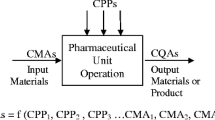Abstract
Using mixture experimental design, the effect of carbomer (Carbopol® 971P NF) and hydroxypropylmethylcellulose (Methocel® K100M or Methocel® K4M) combination on the release profile and on the mechanism of drug liberation from matrix tablet was investigated. The numerical optimization procedure was also applied to establish and obtain formulation with desired drug release. The amount of TP released, release rate and mechanism varied with carbomer ratio in total matrix and HPMC viscosity. Increasing carbomer fractions led to a decrease in drug release. Anomalous diffusion was found in all matrices containing carbomer, while Case — II transport was predominant for tablet based on HPMC only. The predicted and obtained profiles for optimized formulations showed similarity. Those results indicate that Simplex Lattice Mixture experimental design and numerical optimization procedure can be applied during development to obtain sustained release matrix formulation with desired release profile.
Similar content being viewed by others
References
Costa, P. and Sousa-Lobo, J. M., Modeling and comparison of dissolution profiles. Eur. J. Pharm. Sci., 13, 123–133 (2001).
Das, N. G. and Das S. K., Development of mucoadhesive dosage forms of buprenophine for sublingual drug delivery. Drug Dev., 11, 89–95 (2004).
Draganoiu, E., Muca, B., Stansbrey, A., Luo, H., Wilber, W., and Guo, H., Effect of Carbomer and hydroxypropyl methylcellulose combination on drug release from matrix tablets. Eur. J. Pharm. Sci., 25S1, S222–S223 (2005).
Furlanetto, S., Cirri, M., Maestrelli, F., Corti, G., and Mura, P., Study of formulation variables influencing the drug release rate from matrix tablets by experimental design. Eur. J. Pharm. Biopharm., 62, 77–84 (2006).
Hayashi, T., Kanbe, H., Okada, M., Suzuki, M., Ikeda, Y., Onuki, Y., Kaneko, T., and Sonobe, T., Formulation study and drug release mechanism of a new theophylline sustained-release preparation. Int. J. Pharm., 304, 91–101 (2005).
Huang, Y. B., Tsai, Y. H., Yang, W. C., Chang, J. S., and Wu, P. C., Once-daily propranolol extended-release tablet dosage form: formulation design and in vitro/in vivo investigation. Eur. J. Pharm. Biopharm., 58, 607–614 (2004).
Huang, Y. B., Tsai, Y. H., Lee, S. H., Chang, J. S., and Wu, P. C., Optimization of pH-independent release of nicardipine hydrochloride extended-release matrix tablets using response surface methodology. Int. J. Pharm., 289, 87–95 (2005).
Khan, G. M. and Zhu, J. B., Studies on Drug Release Kinetics from Ibuprofen-carbomer hydrophilic matrix tablets: Influence of co-excipients on release rate of the drug. J. Control Release, 57, 197–203 (1999).
Khanna, R., Agarwal, S. P., and Ahuja, A., Muco-adhesive buccal tablets of clotrimazole for oral candidiasis. Drug Dev. Ind. Pharm., 23, 831–837 (1997).
Kiortsis, S., Kachrimanis, K., Broussali, T., and Malamataris, S., Drug release from tableted wet granulations comprising cellulosic (HPMC or HPC) and hydrophobic component. Eur. J. Pharm. Biopharm., 59, 73–83 (2005).
Li, S., Lin, S., Daggy, B. P., Mirchandani, H. L., and Chien, Y. W., Effect of HPMC and Carbopol on the release and floating properties of Gastric floating Drug Delivery System using factorial design. Int. J. Pharm., 253, 13–22 (2003).
Lubrizol, Pharmaceutical Polymers for Controlled Release Tablets and Capsules, Pharmaceutical Bulletin 30, Oct (2008a).
Lubrizol, Formulating Controlled Release Tablets and Capsules with Carbopol® Polymers, Pharm. Bull., 31 (2008b).
Narasimhan, B., Mathematical models describing polymer dissolution: Consequences for drug delivery. Adv. Drug. Del. Rev., 48, 195–210 (2001).
Parojcic, J., Duric, Z., Jovanovic, M., and Ibric, S., An investigation into the factors influencing drug release from hydrophilic matrix tablets based on novel carbomer polymers. Drug Dev., 11, 59–65 (2004).
Perez-Marcos, B., Ford, J. L., Armstrong, D. J., Elliot, P. N. C., Rostron, C., and Hogan, J. E., Release of propranolol hydrochloride from matrix tablets containing hydroxypropyl methylcellulose K4M and Carbopol 974. Int. J. Pharm., 111, 251–259 (1994).
Perez-Marcos, B., Ford, J. L., Armstrong, D. J., Elliot, P. N. C., Rostron, C., and Hogan, J. E., Influence of the pH on the release of propranolol hydrochloride from matrices containing hydroxypropyl methylcellulose K4M and Carbopol 974. J. Pharm. Sci., 85, 330–334 (1996).
Petrovic, A., Trajkovic, S., Ibric, S., Popadic, D., Cvetkovic, N., and Djuric, Z., Theophylline release from aminophylline matrix tablets containing HPMC and Carbopol®. Proc. 5 th World Meeting on Pharmaceutics, Biopharmaceutics and Pharmaceutical Technology, Geneva March 2006, Abstract book, kxksv-∼1 (2006).
Prudat-Christiaens, C., Arnaud, P., Allain, P., and Chaumeil, J. C., Aminophylline bioadhesive tablets attempted by wet granulation. Int. J. Pharm., 141, 109–116 (1996).
Ritger, P. L. and Peppas, N. S., A simple equation for disposition of solute release II: Fickian and anomalous release from swellable devices. J. Control. Release, 5, 37–42 (1987).
Siepman, J. and Peppas, N. A., Modeling of drug release from delivery systems based on hydroxypropylmethylcellulose (HPMC). Adv. Drug. Del. Rev., 48, 139–157 (2001).
Streubel, A., Siepmann, J., and Bodmeier, R., Floating matrix tablets based on low density foam powder: effects of formulation and processing parameters on drug release. Eur. J. Pharm. Sci., 18, 37–45 (2003).
Varshosaz, J., Ghafghazi, T., Raisi, A., and Falamarzian, M., Biopharmaceutical characterization of oral theophylline and aminophylline tablets. Quantitative correlation between dissolution and bioavailability studies. Eur. J. Pharm. Biopharm., 50, 301–306 (2000).
Yuksel, A., Comparison of in vitro dissolution profiles by Anova based model dependent and independent methods. Int. J. Pharm., 209, 57–67 (2000).
Zuleger, S. and Lippold, B. C., Polymer particle erosion controlling drug release. I. Factors influencing drug release and characterization of the release mechanism. Int. J. Pharm., 217, 139–152 (2001).
Zuleger, S., Fassihi, R., and Lippold, B. C., Polymer particle erosion controlling drug release. II. Swelling investigations to clarify the release mechanism. Int. J. Pharm., 247, 23–37 (2002).
Author information
Authors and Affiliations
Corresponding author
Rights and permissions
About this article
Cite this article
Petrovic, A., Cvetkovic, N., Ibric, S. et al. Application of mixture experimental design in the formulation and optimization of matrix tablets containing carbomer and hydroxy-propylmethylcellulose. Arch. Pharm. Res. 32, 1767–1774 (2009). https://doi.org/10.1007/s12272-009-2215-9
Received:
Revised:
Accepted:
Published:
Issue Date:
DOI: https://doi.org/10.1007/s12272-009-2215-9




